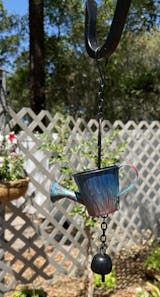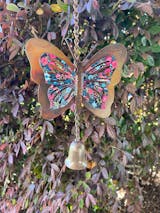The rain gauge, at least as we know it today, is an ornate addition to any garden... and a weather precipitation accumulation gauge. But, what is the history of the first standardized rain gauge? Let's take a closer look as we learn more about how the rain gauge was invented and the first systematic rainfall measurements.
A Brief History of Rain Gauges
The first known rainfall records date back centuries, as far back as the ancient greeks. Throughout history, the King needed a reliable way to measure rain amounts. Having the means to record rainfall helped to indicate how many crops the local land could produce. Therefore, having a way to measure rainfall gave a better idea of how much tax could be charged.
The first standardized rain gauge came from King Sejong in Korea. The standard rain gauge was first invented in the fourth month of 1441, and measured rainfall amounts to determine tax rates.
Later, in 1662, inventor Christopher Wren created the first tipping bucket rain gauge, along with the help of Robert Hooke. This design is still commonly found today and uses a funnel that directs the rain into a larger container.
RELATED: Large Rain Gauge Replacement Tubes
Why Was the Rain Gauge Invented?
As previously mentioned, the measurement of rain recorded was used by the King to determine tax rates for citizens. Rather than estimating the collection of rain on the ground, inventors sought a way to pull more valuable data using a graduated cylinder.
Later, more intricate gauges would be invented that included additional features like tipping buckets and measuring other weather conditions like snow, wind, and hail. More modern rain gauges can even measure the current temperature.
Modern Gauges
Across the world, people measure rain based on designs similar to the originals from centuries ago when the rain gauge was invented. With modern technology, lasers and other added elements help to provide alternative methods to measure rainfall.
What Is a Rain Gauge Made Out Of?
A standard rain gauge consists of a cylinder (approximately 127 mm in diameter) with a brass chamfered rim. Rain falls into the gauge through a funnel and is directed into a storage bin where it can be poured into a graduated cylinder to measure the unit area and later be recorded.
Ideally, a rain gauge should be placed in an area with no obstacles impacting rainfall into the collection device. Also, the indicator should be set in an area where the wind will have minimal impact on the collection.
Types of Rain Gauges
Many of the rain gauges of today are modeled from the original created by Robert Hooke. The most common types of rain gauges today are:
Graduated Cylinder Rain Gauge
The most simple way to measure precipitation is with the cylinder rain gauge. This model uses a cylinder, a funnel, and a plastic tube to collect rainfall measurements.
Tipping Bucket Rain Gauge
A slightly more complex rain gauge is the tipping bucket rain gauge design that uses a funnel, cylinder, and buckets. As weather permits, the tipping bucket rain gauge has buckets that fill with rainfall and spill into a larger storage bin.
The rain gauge tipping bucket collects approximately 0.01 inches of rain and tips over. Each time it tips, the gauge tipping bucket rain collector sends an electronic signal to a computer.
Weighing Rain Gauge
A weighing precipitation gauge uses a cylinder and an electronic scale to calculate the indirect measurement of rainfall.
Optical Rain Gauge
Another more complicated model is the optical rain gauge which utilizes a light source to detect and measure rain. In addition to measuring rainfall, optical rain gauges can also be used for wind. These gauges are much more modern and expensive.
Acoustic Rain Gauge
An acoustic rain gauge measures rainfall by sensing rain sounds. This gauge can estimate rain based on the size of the raindrops, as measured through sound.
Who Uses Rain Gauges?
Rain gauges are used by all. From hydrologists to meteorologists, scientists across the globe use rain gauges for the measurement of precipitation. Measuring the rain is a crucial element of weather forecasting, large construction projects, and cropping patterns.
It's also common to find rain gauges that are both practical tools and ornament pieces in any garden. Whether you're interested in more closely managing your crops or feeding your curiosity, a rain gauge is an excellent addition.
Find Rain Gauges at Happy Gardens
Shopping for a rain gauge at the Happy Gardens Store is highly recommended for gardeners who aren't willing to compromise on quality or craftsmanship. Here, you can search through our rain gauge collection to find something that matches your garden's aesthetic, like this charming Old Fashioned Turtle Rain Gauge (keep this link - it's new).
Feel free to reach out to the garden experts at Happy Gardens if you need assistance. After all, here at Happy Gardens, we're happy to help!














Leave a comment